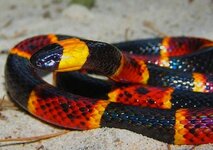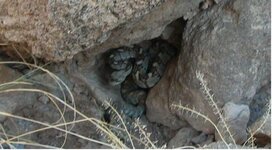elgatodelnoche
Sr. Member
- Aug 21, 2013
- 333
- 119
- Detector(s) used
- Garrett Deepseeker ADS
- Primary Interest:
- Prospecting
- Thread starter
- #21
@ Carl-NC: Science.
@ Thommy: It is absolutely a North American Coral Snake. Red touch yellow kills a fellow. If red does not touch yellow, then you have a King snake. I am not saying the Spanish left snakes, only that I believe an accumulation of Gold would attract them like asphalt attracts them. I am going to start getting out in the Supers very soon so I hope to see lots of snakes when they wake up in the spring. I love your minnie ball mystery as much as I love to eat beer battered crawdads! Yum!
I used to kill snakes, but now I just move them out of my way or I get out of theirs. I stepped right over a sidewinder once at Date Creek digging for Quartz crystals. He just moved on as did I.
@ Thommy: It is absolutely a North American Coral Snake. Red touch yellow kills a fellow. If red does not touch yellow, then you have a King snake. I am not saying the Spanish left snakes, only that I believe an accumulation of Gold would attract them like asphalt attracts them. I am going to start getting out in the Supers very soon so I hope to see lots of snakes when they wake up in the spring. I love your minnie ball mystery as much as I love to eat beer battered crawdads! Yum!
I used to kill snakes, but now I just move them out of my way or I get out of theirs. I stepped right over a sidewinder once at Date Creek digging for Quartz crystals. He just moved on as did I.







